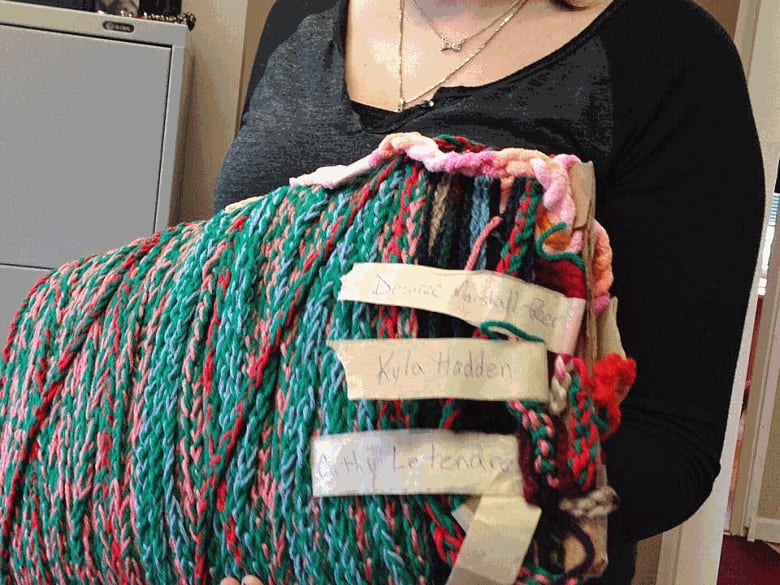Northern Gateway tanker threat spurs First Nation's yarn 'blockade'
Women crochet a 'Chain of Hope' to preserve the marine environment

Members of Hartley Bay First Nation have stretched a 4.6-kilometre long crocheted rope across B.C.'s Douglas Channel in a symbolic blockade of the future path of oil supertankers in northern B.C.
About 200 people from the coastal community gathered at the narrow channel Friday to make the point that they will do everything they can to stop the Northern Gateway pipeline project.
- Next stop for Northern Gateway: the courts
- Northern Gateway pipeline approved with 209 conditions
- Northern Gateway: B.C. reacts
- Exclusive: Pipeline safety incident rate doubled in past decade
If the pipeline is built, more than 220 tankers would travel through the channel on their way from Kitimat to the Pacific Ocean each year, carrying Alberta oilsands bitumen west to Asia. Tankers would also bring diluting agents into Kitimat to be carried east in a second pipeline to Alberta, in order to get the bitumen to flow through the pipeline.
"I look out my window and I can see the Douglas Channel and those tankers will be right in front of our door step," said Lynne Hill who came up with the idea of a blockade.

"We can't stand on the water as you would if you were going to blockade the road. I just thought that many women create beautiful things in their homes out of crochet — that somehow we can use that."
The federal cabinet gave the project the green light on Tuesday. The energy company Enbridge still has to meet 209 conditions set the by National Energy Board before the oil can flow through the pipeline.
But the opposition in B.C. has been fierce, with 130 First Nations and two-thirds of B.C.'s population opposed. The provincial government also says its five conditions for approval haven't been met.
'Fragile link'
Hill said that for the past three to four months people in Hartley Bay have been doing their bit to block the project. Women ranging in age from four to 80 years old have been getting together to crochet the Chain of Hope, using everything from wool and twine to the occasional cork float normally used on fishing nets.
"The line symbolizes so many things — it's a fragile link," said Hill in a telephone interview with CBC News. "One of the ladies described each stitch is shaped like a tear drop, because this is a very emotional thing for us."
Hartley Bay would essentially be ground zero if any of the oil tankers broke up in the channel. Five court cases including one from Gitga'at First Nations who live in Hartley Bay, are heading to the Federal Court of Appeal. They are arguing the NEB didn't properly study the wider environmental effects of the project.
Political hot potato
The project is so hot politically that the federal ministers involved in the decision have mostly avoided talking about it other than from the controlled safety of the House of Commons, until B.C. minister James Moore's appearance on CBC News Network's Power & Politics Friday.
Natural Resources Minister Greg Rickford told an oil and gas industry audience in St. Johns on Friday that his government is committed to engaging First Nations in resource projects.

"I've seen first-hand from my time on the north British Columbia coast that they have local knowledge and expertise made to make these systems work."
But Rickford avoided mentioning the Northern Gateway project by name to the industry audience, despite the fact it's the largest pipeline project his government has approved to date.
Enbridge has signed equity agreements with 26 of the 40 First Nations communities in Alberta and B.C., that would be directly affected by the pipeline route.
The company has also promised up to $300 million in estimated employment and contracts for First Nations along the route.
But Hill said that's small comfort to people in Hartley Bay whose everyday existence is based on fishing and the pristine ocean environment.
"Even though we are very small, we have everything to lose and we're going to do what it takes to make sure we can try to protect what we have," she said.
Hill said they will eventually take the Chain of Hope out of the water and symbolically burn it, part of their aboriginal tradition to use fire to send valuable possessions on to those who have died.